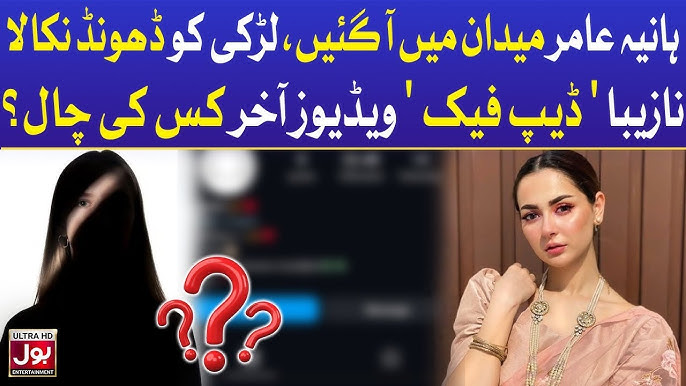Introduction
Hania Aamir Viral Video Controversy
In recent months, a series of videos and online content has thrust Pakistani actress Hania Aamir into controversy. For instance, people claim some videos show her, while others dismiss them outright as “deepfakes.” Moreover, social media buzzes with rumors, manipulated content, and sensational headlines, so the public struggles to separate fact from fiction. Therefore, this article unpacks the controversy, scrutinizes credible evidence, and breaks down confirmed facts, unverified claims, as well as key lessons for privacy, AI ethics, and media responsibility.
Who Is Hania Aamir?
Hania Aamir is a well-known Pakistani film and television actress and model. She has starred in popular dramas and films, and has a strong following on social media. Her roles in series like Janaan, Mere Humsafar, Titli, among others, have made her a recognizable face in Pakistani entertainment.
Her popularity also extends beyond Pakistan, which increases both her visibility and vulnerability to viral rumors.
What Triggered the Controversy

Several incidents converge around what has been called the “Hania Aamir viral video controversy.” Key triggers include.
- A Deepfake Video
- A video showing a woman who resembles Hania Aamir in bold poses and revealing attire spread online, and many initially believed it depicted Hania herself. The Express Tribune +2, Pakistan Observer +2
- False Claims / Fake Interactions
- Tech influencers and other creators posted videos or content that falsely claimed Hania messaged them—for instance, asking for camera zoom tips—or interacted with them in ways she denies. They displayed alleged screenshots, but Hania insists she never sent those messages. Daily Times +1
- Fake Statements / Misattributed Posts
- Fabricators created some social media posts and attributed them to Hania on sensitive political issues or recent tragedies. She has publicly denounced these fake quotes and messages. The Express Tribune +2, Pak Showbiz +2
What Is Confirmed
Reliable sources strongly support these facts:
- Hania Aamir publicly denied the deepfake video content. She clarified that AI generated the video showing her in revealing attire and that it does not feature her.
- She identified the account allegedly responsible for spreading deepfake content: “Anureet Sandhu.” This account used several fake AI videos featuring her face.
- She urged her fans and the general public to report such accounts, avoid sharing unverified content, and call for stricter regulation over AI misuse.
- Reliable sources confirm that the viral content caused concern, confusion, and emotional distress—not only for Hania but also for fans and observers whom it misled.
What Remains Unverified or False
These are claims in circulation that lack credible evidence or have been debunked:
| Claim | Status / Evidence |
|---|---|
| That Hania Aamir really sent messages to tech influencers asking for unusual camera zoom tips (e.g. beyond normal limits) | False. She has denied sending such messages; the screenshots shown are alleged fabrications. Daily Times |
| That a nude or fully explicit video of Hania Aamir was leaked and is authentic | Unverified / False. Fact-checkers report no credible source, video, or investigation confirming such a video. Many posts use images from past photoshoots and clickbait headlines. Soch Fact Check |
| That she made controversial political statements (e.g. blaming certain institutions in context of sensitive events such as the Pahalgam attack) | False. She has publicly refuted such posts, saying they are misattributed, fabricated, and do not reflect her views. The Express Tribune+1 |
The Deepfake Issue: What Evidence Exists
The deepfake aspect is central to separating fact from misinformation.
Key Statements and Evidence
- Hania Aamir herself stated publicly that AI generated the controversial video and that it does not feature her. She emphasized her concern over technology misuse.
- She identified the profile “Anureet Sandhu” (based in India, according to reports) as a source for videos that falsely attribute content to her, including ones where creators superimposed her face.
- The account in question reportedly changed names multiple times to avoid detection or reporting.
These facts provide strong indications of deliberate deepfake misuse. However, no one has publicly disclosed full forensic confirmation of the technical metadata (original video files, digital fingerprints) or the identity of the person(s) who originally created the manipulated content.
Public Reaction & Media Behavior
The controversy sparked widespread responses:
- Fans and followers generally supported Hania, expressing sympathy over what many viewed as a violation of privacy and personal dignity.
- Critics emphasized the danger of unverified content, especially in the age of AI tools that make it easier to convincingly alter images or video.
- Some media outlets were criticized for publishing sensational headlines without confirming facts—contributing to the spread of rumors.
- Social media platforms came under scrutiny for how quickly misleading content can spread, and for lacking sufficient filters or fact-checks around deepfake content.
Core Insights
Putting together confirmed details and false or unverified claims yields these core insights:
Fiction: Hania Aamir created or approved all viral content that people attribute to her. Fabricators invented many viral claims, such as sexting, certain messages, and political statements.
Fact: Attackers used deepfake technology to generate false videos or images that bear her likeness. She denies any involvement and takes steps to report and counteract those misuses.
Fiction: Spreading fake content harms no one or carries little weight. In reality, it creates significant emotional, reputational, and ethical fallout.
Fact: This case spotlights broader issues, including AI misuse, weak regulation, media irresponsibility, and the urgent need for public media literacy.
Legal, Ethical, and Technological Implications

This controversy isn’t just celebrity gossip—it raises serious issues:
- Privacy rights and identity protection
Misattribution of content or use of someone’s likeness without consent infringes on privacy and individual rights. When it’s misleading or defamatory, it can also be actionable legally. - Regulation of AI and deepfake content
As Hania has pointed out, there is a pressing need for better legal frameworks to prevent misuse of AI to harm individuals. Many countries are debating laws around deepfakes; this case shows real, contemporary harm. - Media responsibility
Journalists and content creators have a responsibility to verify sources. Publishing sensational or misleading info may get traffic, but it can damage reputations and misinform the public. - Public trust and media literacy
Audiences need to develop critical thinking: checking sources, verifying posts, being wary of clickbait, not accepting manipulated screenshots or posts without corroboration. - Psychological impact on those targeted
Being falsely represented, misquoted, or having one’s likeness used in explicit or misleading contexts can cause stress, anxiety, and damage to mental health.
Timeline of Key Events
| Date / Period | What Happened |
|---|---|
| September 2024 | A deepfake video resembling Hania Aamir in revealing content surfaced; media sites and social media first mistakenly identified the woman in the video as her. Hania publicly denied the video was hers. The Express Tribune+2viralnom.com+2 |
| Around same time | She tracked down the Instagram account “Anureet Sandhu,” flagged multiple AI-generated videos using her face, urged followers to report the account. The Express Tribune |
| May 2025 | A tech influencer claimed Hania messaged him asking about phone camera zoom; Hania denied it, citing the screenshot was fake. Daily Times |
| After Pahalgam attack (April 2025) | A fake post circulated attributing political statements to Hania Aamir about the attack. She refuted them, saying the posts did not represent her and were fabricated. The Express Tribune+1 |
Practical Tips to Avoid Being Misled
To avoid deception, follow these practical tips, which can help you navigate online misinformation more effectively:
- Finally, refrain from sharing content unless you feel confident it comes from credible sources; sharing rumors only amplifies the harm, and pausing to think can prevent widespread damage.
- First, check if multiple reliable sources report the content, rather than relying solely on social media pages or clickbait sites, because verification from trusted outlets adds credibility.
- Next, look for statements from the person involved—if Hania denies a claim, that provides strong evidence, and it often clarifies the situation quickly.
- Additionally, stay skeptical of screenshot “proof”—people easily fabricate or edit these, so always question their authenticity before accepting them.
- Moreover, run a reverse image search to check if someone repurposed photos from old photoshoots or elsewhere, as this simple step can reveal origins in seconds.
- Furthermore, watch for telltale signs of deepfakes, such as unnatural lighting, blurry or mismatched edges around the face, odd skin textures, strange proportions, or unnatural motion, since these inconsistencies often betray manipulation.
Broader Lessons: What This Tells Us about the Digital Age
The Hania Aamir controversy is not just a celebrity scandal—it reflects deeper cultural, legal, and technological shifts.
- AI is powerful and double-edged. Tools for image/video manipulation are increasingly accessible. While they have creative and practical benefits, misuse is rising.
- Legal systems are lagging. Many jurisdictions lack clear laws specifically addressing deepfakes, identity misuse, and AI-generated defamatory content. Victims often have to plead for takedowns or legal recourse after damage is already done.
- Media speed vs accuracy trade-off. In the rush to be first, many media outlets publish misleading or sensational content without thorough verification.
- Public pressure and activism matter. Hania had to publicly speak out, rally fans, and identify accounts to force action. Without that, many false claims would go unchallenged.
- Ethical responsibility of creators and platforms. Platforms (Instagram, TikTok, etc.) hosting such content have a role to play in detection, reporting tools, and removal. Content creators need to weigh the consequences of spreading unverified claims.
Conclusion
The Hania Aamir viral video controversy is a complex mixture of fact, fiction, and the gray area in between. What is clear:
- The controversial video(s) are not hers—they are deepfake or AI-generated.
- Many rumors and claims (fake messages, false quotes) have no basis in fact.
- Hania Aamir has consistently and publicly disavowed misattributed content and called for greater responsibility from media, fans, and platforms.
Ultimately, this case underscores how vulnerable public figures are in the digital era—and how important it is for everyone (media, creators, audience) to act with caution, verification, and respect for truth and privacy.
SEO Keywords & Meta Data Suggestions
Keywords / Phrases to use throughout article:
- Hania Aamir viral video
- Hania Aamir deepfake
- Hania Aamir fake video controversy
- is the Hania Aamir video real or fake
- false messages attributed to Hania Aamir
- AI-generated video Hania Aamir
- identify fake videos social media
- Hania Aamir denies fake video




